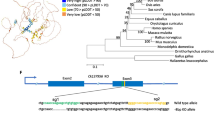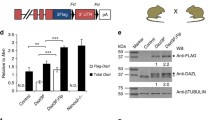Abstract
Spermatogenesis is a complex process subject to strict controls at both levels of transcription and translation. It has been proposed that DAZL protein binds to RNA in the cytoplasm of germ cells and controls spermatogenesis. In male mice, loss of Dazl results in numerous defects throughout the mitotic and meiotic process of germ cell development. Tex19.1 also plays an important role during spermatogenesis and Tex19.1−/− knockout males exhibit impaired spermatogenesis. Mouse DAZL protein can bind to 3′UTR of mTex19.1 mRNAs and may repress mTex19.1 expression at the translational level. These have been confirmed by both electrophoretic mobility shift assay and translation assay in Zebrafish embryo detecting the luciferase activity. Taken together these data suggest that mDazl may regulate mTex19.1 expression through binding to 3′UTR of mTex19.1 mRNAs in germ cells.


Similar content being viewed by others
References
Willison K, Ashworth A (1987) Mammalian spermatogenic gene expression. Trends Genet 3:351–355. doi:10.1016/0168-9525(87)90296-4
Sutcliffe MJ, Burgoyne PS (1989) Analysis of the testes of H-Y negative XOSxrb mice suggests that the spermatogenesis gene (Spy) acts during the differentiation of the A spermatogonia. Development 107:373–380
Foresta C, Moro E, Ferlin A (2001) Y Chromosome microdeletions and alterations of spermatogenesis. Endocr Rev 22:226–239. doi:10.1210/er.22.2.226
Xu EY, Moore FL, Reijo RP (2001) A gene family required for human germ cell development evolved from an ancient meiotic gene conserved in metazoans. Proc Natl Acad Sci USA 98:7414–7419. doi:10.1073/pnas.131090498
Xu EY, Lee DF, Klebes A et al (2003) Human BOULE gene rescues meiotic defects in fertile flies. Hum Mol Genet 12:169–175. doi:10.1093/hmg/ddg017
Chai NN, Phillips A, Fernandez A et al (1997) A putative human male infertility gene DAZLA: genomic structure and methylation status. Mol Hum Reprod 3:705–708. doi:10.1093/molehr/3.8.705
Saxena R, Brown LG, Hawkins T et al (1996) The DAZ gene cluster on the human Y chromosome arose from an autosomal gene that was transposed, repeatedly amplified and pruned. Nat Genet 14:292–298. doi:10.1038/ng1196-292
Ruggiu M, Speed R, Taggart M et al (1997) The mouse DAZLA gene encodes a cytoplasmic protein essential for gametogenesis. Nature 389:73–77. doi:10.1038/37987
Saunders PTK, Turner JMA, Ruggui M et al (2003) Absence of mDazl produces a final block in germ cells development at meiosis. Reproduction 126:589–597. doi:10.1530/rep.0.1260589
Slee R, Grimes B, Speed RM et al (1999) A human DAZ transgene confers partial rescue of the mouse Dazl null phenotype. Proc Natl Acad Sci USA 96:8040–8045. doi:10.1073/pnas.96.14.8040
Maines JZ, Wasserman SA (1999) Post-transcriptional regulation of the meiotic Cdc25 protein Twine by the Dazl orthologue Boule. Nat Cell Biol 1:171–174. doi:10.1038/11091
Jiao X, Trifillis P, Kiledjian M (2002) Identification of target messenger RNA substrates for the murine deleted in azoospermia-like RNA-binding protein. Biol Reprod 66:475–485. doi:10.1095/biolreprod66.2.475
Fox M, Urano J, Reijo Pera RA (2005) Identification and characterization of RNA sequences to which human PUMILIO-2 (PUM2) and deleted in Azoospermia-like (DAZL) bind. Genomics 85:92–105. doi:10.1016/j.ygeno.2004.10.003
Reynolds N, Collier B, Bingham V et al (2007) Translation of the synaptonemal complex component Sycp3 is enhanced in vivo by the germ cell specific regulator Dazl. RNA 13:1–8. doi:10.1261/rna.465507
Reynolds N, Collier B, Maratou K et al (2005) Dazl binds in vivo to specific transcripts and can regulate the pre-meiotic translation of Mvh in germ cells. Hum Mol Genet 14:3899–3909. doi:10.1093/hmg/ddi414
Zeng M, Deng WQ, Wang XY et al (2008) DAZL binds to the transcripts of several Tssk genes in germ cells. BMB Rep 41:300–304
Collier B, Gorgoni B, Loveridge C et al (2005) The DAZL family proteins are PABP-binding proteins that regulate translation in germ cells. EMBO J 24:2656–2666. doi:10.1038/sj.emboj.7600738
Westerfield M (1993) The Zebrafish book. University of Oregon Press, Oregon
Kimmel CB, Ballard WW, Kimmel SR et al (1995) Stages of embryonic development of the zebrafish. Dev Dyn 203:253–310
King PH (2000) RNA-binding analyses of Huc and HuD with the VEGF and c-myc 3-untranslated regions using a novel ELISA-based assay. Nucleic Acids Res 28:E20. doi:10.1093/nar/28.7.e20
Zhang S, Qiu W, Wu H, Zhang G et al (2001) The shorter zinc finger protein ZNF230 gene message is transcribed in fertile male testes and may be related to human spermatogenesis. Biochem J 359:721–727. doi:10.1042/0264-6021:3590721
Ollinger R, Childs AJ, Burgess HM et al (2008) Deletion of the pluripotency-associated Tex19.1 gene causes activation of endogenous retroviruses and defective spermatogenesis in mice. PLoS Genet 9:1–16
Moore FL, Jaruzelska J, Fox MS et al (2003) Human Pumilio-2 is expressed in embryonic stem cells and germ cells and interacts with DAZ (deleted in azoospermia) and DAZ-like proteins. Proc Natl Acad Sci USA 100:538–543. doi:10.1073/pnas.0234478100
Urano J, Fox MS, Reijo PRA (2005) Interaction of the conserved meiotic regulators, BOULE (BOL) and PUMILIO-2 (PUM2). Mol Reprod Dev 71:290–298. doi:10.1002/mrd.20270
Morton S, Yang HT, Moleleki N et al (2006) Phosphorylation of the ARE-binding protein DAZAP1 by ERK2 induces its dissociation from DAZ. Biochem J 399:265–273. doi:10.1042/BJ20060681
Reijo RP, Dorfman DM, Slee R (2000) DAZ family proteins exist throughout male germ cell development and transit from nucleus to cytoplasm at meiosis in humans and mice. Biol Reprod 63:1490–1496. doi:10.1095/biolreprod63.5.1490
Wang PJ, Page DC, McCarrey JR (2005) Differential expression of sex-linked and autosomal germ-cell-specific genes during spermatogenesis in the mouse. Hum Mol Genet 14:2911–2918. doi:10.1093/hmg/ddi322
Acknowledgments
This work was supported by National High-Tech Research and Development Program of China (2008AA02Z102) and the grant of National Natural Science Foundation of China (No. 90408025, No. 30770812 and No. 30500186).
Author information
Authors and Affiliations
Corresponding authors
Rights and permissions
About this article
Cite this article
Zeng, M., Lu, Y., Liao, X. et al. DAZL binds to 3′UTR of Tex19.1 mRNAs and regulates Tex19.1 expression. Mol Biol Rep 36, 2399–2403 (2009). https://doi.org/10.1007/s11033-009-9470-1
Received:
Accepted:
Published:
Issue Date:
DOI: https://doi.org/10.1007/s11033-009-9470-1




